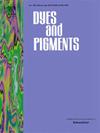基于硒吩的化学发光单体的合成和电聚合及其在血液检测中的应用
IF 4.1
3区 工程技术
Q2 CHEMISTRY, APPLIED
引用次数: 0
摘要
通过电子供体-受体-供体方法,分两步合成了一种新的硒吩基三聚化学发光化合物,即 5,7-二(硒吩-2-基)-2,3-二氢噻吩并[3,4-d]哒嗪-1,4-二酮(S2T-Lum)。在碱性溶液中,在不同催化剂(如不同金属离子、hemin 和血液样本)的存在下,研究了它与过氧化氢的化学发光反应,并将结果与其噻吩类似物(T2T-Lum)和发光酚进行了比较。结果发现,S2T-Lum 对铜(II)和铁(III)离子以及血液样本非常敏感。同时,可以很容易地得出结论,S2T-Lum 作为发光酚类化合物的新成员,是法医学中检测血液结果的潜在候选化合物。此外,S2T-Lum 在 1.28 V 对 Ag/AgCl 的电压下有一个不可逆的氧化峰,这是由它的电聚合作用引起的。S2T-Lum 通过电位动力电解法成功实现了电化学聚合,其化学发光活性附属物没有发生裂解。据我们所知,其相应的聚合物 PS2T-Lum 薄膜是第一种基于硒吩的发光酚型电活性聚合物。本文章由计算机程序翻译,如有差异,请以英文原文为准。
Synthesis and electropolymerization of a selenophene based chemiluminescent monomer and its use in blood detection
A new selenophene based trimeric chemiluminescent compound, namely 5,7-di(selenophen-2-yl)-2,3-dihydrothieno[3,4-d]pyridazine-1,4-dione (S2T-Lum), was synthesized in two steps via electron donor-acceptor-donor approach. Its chemiluminescent reaction with hydrogen peroxide was investigated in an alkaline solution in the presence of various catalysts such as different metal ions, hemin and blood samples and the results were compared with its thiophene analogue (T2T-Lum) and luminol. It was found that S2T-Lum was very sensitive to copper(II) and iron(III) ions, and blood samples. Also, it can be easily concluded that S2T-Lum as a new member of luminol type compounds is a potential candidate for the detection of blood findings in forensic science. Furthermore, S2T-Lum has an irreversible oxidation peak at 1.28 V vs Ag/AgCl, which is responsible from its electropolymerization. S2T-Lum was successfully polymerized electrochemically via potentiodynamic electrolysis without cleavage of its chemiluminescent active appendage. To the best of our knowledge, its corresponding polymer PS2T-Lum film is the first member of selenophene based luminol type electroactive polymers.
求助全文
通过发布文献求助,成功后即可免费获取论文全文。
去求助
来源期刊

Dyes and Pigments
工程技术-材料科学:纺织
CiteScore
8.20
自引率
13.30%
发文量
933
审稿时长
33 days
期刊介绍:
Dyes and Pigments covers the scientific and technical aspects of the chemistry and physics of dyes, pigments and their intermediates. Emphasis is placed on the properties of the colouring matters themselves rather than on their applications or the system in which they may be applied.
Thus the journal accepts research and review papers on the synthesis of dyes, pigments and intermediates, their physical or chemical properties, e.g. spectroscopic, surface, solution or solid state characteristics, the physical aspects of their preparation, e.g. precipitation, nucleation and growth, crystal formation, liquid crystalline characteristics, their photochemical, ecological or biological properties and the relationship between colour and chemical constitution. However, papers are considered which deal with the more fundamental aspects of colourant application and of the interactions of colourants with substrates or media.
The journal will interest a wide variety of workers in a range of disciplines whose work involves dyes, pigments and their intermediates, and provides a platform for investigators with common interests but diverse fields of activity such as cosmetics, reprographics, dye and pigment synthesis, medical research, polymers, etc.
 求助内容:
求助内容: 应助结果提醒方式:
应助结果提醒方式:


